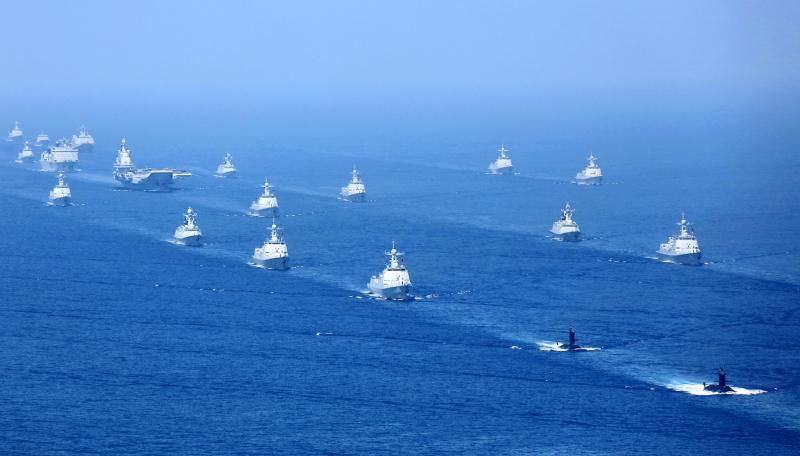A Chinese People’s Liberation Army Navy (PLAN) training mission in March involving the aircraft carrier Liaoning sailing through waters between Japan and Taiwan, and into the South China Sea, was a maneuver aimed at “hitting three birds with one stone,” a local defense analyst said.
Wang Tsun-yen (王尊彥), an assistant research fellow at the Institute for National Defense and Security Research’s division of non-traditional security and military division, made the comment in a piece in the debut issue of the Defense Security Biweekly published on Friday last week.
The Liaoning’s long-range training mission, which began on April 10, took it through the Miyako Strait near Okinawa, past eastern Taiwan and into the South China Sea through the Bashi Channel, could have been in response to two maritime incidents involving Japan and Vietnam, Wang said.

Photo: Xinhua via AP
On March 30, a Chinese fishing boat collided with the Japanese destroyer Shimakaze in the East China Sea, while on April 2, a Chinese Coast Guard vessel sank a Vietnamese fishing boat in the South China Sea.
There were 10 injuries, but no loss of life in the two incidents.
Beijing’s decision to sail the Liaoning and its escort through waters near Japan instead of going to the South China Sea directly through the Taiwan Strait, showed that the voyage was targeted at Japan, but also designed to exert pressure on Vietnam, Wang said.
The Chinese fishing boat’s collision with the Japanese destroyer could be part of an asymmetric move to drive Japan’s Self-Defense Force out of the area, he said, citing reports that the Chinese fishing boat was actually a military vessel.
The incident in the South China Sea was not the first time China and Vietnam had clashed at sea, and Beijing might have wanted to teach Hanoi a lesson about getting too close to Japan and the US, Wang said, citing the visit of the Japanese helicopter carrier Izumo to Vietnam in June last year, and a port call of US aircraft carrier Theodore Roosevelt last month.
As most US aircraft carriers are docked due to the COVID-19 pandemic, Beijing wants to convey the message that “the US big brother is not reliable” and that the “Chinese People’s Liberation Army is not affected by the outbreak and still can go to your doorsteps,” Wang said.
“With the Chinese navy fleet’s sailing routes, it is quite obvious that China wants to show its muscle to Japan, Vietnam and Taiwan, with a strategy aimed at hitting three birds with one stone,” he said.
However, China does not want to further escalate tensions on two fronts at the same time, as Japan and Vietnam both play important geopolitical roles and Beijing itself is busy handling internal and external problems, including the pandemic, Wang said.
As Japan and Vietnam have strengthened two-way security cooperation, including the signing of several agreements and Tokyo’s donations of patrol boats to Vietnam amid China’s increased assertiveness, any easing of tension in the region is unlikely in the near term, Wang said.

US climber Alex Honnold is to attempt to scale Taipei 101 without a rope and harness in a live Netflix special on Jan. 24, the streaming platform announced on Wednesday. Accounting for the time difference, the two-hour broadcast of Honnold’s climb, called Skyscraper Live, is to air on Jan. 23 in the US, Netflix said in a statement. Honnold, 40, was the first person ever to free solo climb the 900m El Capitan rock formation in Yosemite National Park — a feat that was recorded and later made into the 2018 documentary film Free Solo. Netflix previewed Skyscraper Live in October, after videos

Starting on Jan. 1, YouBike riders must have insurance to use the service, and a six-month trial of NT$5 coupons under certain conditions would be implemented to balance bike shortages, a joint statement from transportation departments across Taipei, New Taipei City and Taoyuan announced yesterday. The rental bike system operator said that coupons would be offered to riders to rent bikes from full stations, for riders who take out an electric-assisted bike from a full station, and for riders who return a bike to an empty station. All riders with YouBike accounts are automatically eligible for the program, and each membership account

A classified Pentagon-produced, multiyear assessment — the Overmatch brief — highlighted unreported Chinese capabilities to destroy US military assets and identified US supply chain choke points, painting a disturbing picture of waning US military might, a New York Times editorial published on Monday said. US Secretary of Defense Pete Hegseth’s comments in November last year that “we lose every time” in Pentagon-conducted war games pitting the US against China further highlighted the uncertainty about the US’ capability to intervene in the event of a Chinese invasion of Taiwan. “It shows the Pentagon’s overreliance on expensive, vulnerable weapons as adversaries field cheap, technologically

NUMBERs IMBALANCE: More than 4 million Taiwanese have visited China this year, while only about half a million Chinese have visited here Beijing has yet to respond to Taiwan’s requests for negotiation over matters related to the recovery of cross-strait tourism, the Tourism Administration said yesterday. Taiwan’s tourism authority issued the statement after Chinese-language daily the China Times reported yesterday that the government’s policy of banning group tours to China does not stop Taiwanese from visiting the country. As of October, more than 4.2 million had traveled to China this year, exceeding last year. Beijing estimated the number of Taiwanese tourists in China could reach 4.5 million this year. By contrast, only 500,000 Chinese tourists are expected in Taiwan, the report said. The report